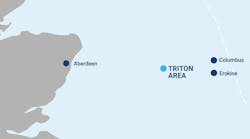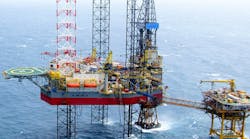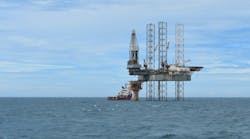Hilary McCutcheon
Wood Mackenzie Consultants Ltd.
Current levels of activity in the Caspian Sea clearly reflect the efforts of the littoral states to attract interest and investment. While the Kazakh and Russian offshore sectors are heating up with a number of exploration projects, interest is cooling off toward the south with the more intractable positions of Turkmenistan and Iran. The Azeri sector is, as always, a mixed bag of mature state-owned projects and international exploration consortia that badly need some good news.
The general perception of the Caspian is that it consists of only two or three "mega-projects" and nothing else. While it is true that a handful of mega-projects will come to dominate the picture, a closer look reveals a surprising number of projects and participants – and a lot of potential.
Recent and prospective asset deals show there is still scope for entrants at many levels. This is likely to continue as some of the smaller players begin to feel the effects of protracted exploration and appraisal programs, and the larger projects enter significant investment phases.
Azerbaijan
Progress at Azeri-Chirag-Guneshli continues after Phase 2 sanction in September 2002. Pre-drilling at Central Azeri was to conclude in 2Q 2003, with pre-drilling at West Azeri to follow. Baku-Tbilisi-Ceyhan pipeline construction began in 1Q 2003, with pipelay beginning in late April. The BTC pipeline is expected to transport Phase 1 oil from ACG in early 2005.
Lukoil's sale of its stake in the ACG project to Inpex in December 2002 should provide the company with the cash to pursue its many other projects in the northern Caspian. The sale price of $1.35 million for the 10% stake is significantly higher than the Wood Mackenzie valuation of $1.16 million. The company increased its interest in the enlarged Yalama (D222) licence to 80% in April 2003 and is planning to drill its first well on the block in the second half of 2004 using the DSS-20. If successful, Lukoil may upgrade the Shelf 7 semisubmersible for further drilling on the license.
Shah Deniz, the only success to date in Azer-baijan's new wave of offshore exploration, should make significant progress in 2003 following Phase 1 sanction in February. Statoil was named commercial operator for the project (transportation and marketing), with BP remaining the upstream operator. Pre-drilling of three wells began from the Istiglal rig in April 2003.
Drilling at other offshore exploration blocks continues to prove challenging with further disappointment at Japan Azerbaijan Oil Co.'s second well at Yanan Tava. The next wells to be spudded will be at ExxonMobil's Zafar Mashal and Nahchivan blocks in September 2003 and 2Q 2004 respectively. These will be drilled using the new DSS-20 semisubmersible, which is on schedule for completion in 3Q 2003. Drilling will also take place in 2004 at BP's Inam and Lukoil's Yalama.
Beyond the international projects, Socar is not planning any exploration drilling in 2003, deciding instead to continue efforts to slow production decline at more mature state-owned fields. The focus is on development drilling and facilities optimization rather than further exploration. Socar also has plans to convert drilling rigs for use as production platforms at Neft Dashlary and Darwin Bankasy.
Iran
There is very little to report in the Iranian sector of the Caspian since the SCES consortium (Shell, Eni, Petro-Canada, and National Iranian Oil Co. subsidiary Kepco) relinquished its licence to the entire area traditionally claimed by Iran (straight line between its border points with Turkmenistan and Azerbaijan) in mid-2002.
Iran maintains there should be no exploration in disputed areas until an agreement can be reached on division of the Caspian. As this still involves Iran claiming a 20% share of the total area, this issue is unlikely to be resolved in the near future.
Kazakhstan
Although all eyes are on Kashagan to launch North Caspian production in 2005-06, smaller-scale fields such as Buzachi North and Arman have been producing for several years and are expected to account for almost 20,000 b/d in 2003.
Agip KCO plans to build on its 2002 success at Kashagan and Kalamkas A with additional wells in 2003. Structures Kairan and Aktote are to be drilled in 2Q 2003 and 3Q 2003 respectively with the first well on Kashagan Southwest spudded in May 2002. Artificial islands have been constructed from which to drill.
Success at these undrilled structures would raise a number of questions, predominantly how adequate infrastructure can be sourced to develop these reserves on a time scale acceptable to the Kazakhstan authorities and how to fund such a development without risking substantial overexposure to the Caspian markets.
India's Oil and Natural Gas Corp.'s hopes of finally gaining an interest in Kazakhstan were dealt another blow in March when it failed to secure any of BG's 16.7% stake in Agip KCO. With major funding ongoing at Karachaganak, BG sought to reduce its exposure in Kazakh-stan. In two separate deals, the company agreed to sell 8.3% stakes to the Chinese state-owned companies China National Offshore Oil Corp. and Sinopec for $615 million apiece. This would have been a major acquisition for the Chinese companies in the Caspian region and a key part of their international expansion plans. However, the subsequent decision by all existing partners (except Inpex) to pre-empt the purchase has resulted in both Chinese parties being blocked from the consortium. The move has met with immediate disapproval from both the Kazakh and Chinese governments, and repercussions may be damaging, especially for Shell and ExxonMobil, which are particularly active in China.
ONGC also looked at Kurmangazy (where it announced it expected to acquire 10% from KazMunaiGaz in January 2003), Kazakhoil-Aktobe's onshore Alibekmola and Kozhasai fields (potential 15% stake), and the offshore Darkhan structure (as yet unlicensed). So far, the company has failed to secure any agreements. ONGC already has considerable experience in shallow-water operations around India's northwest and southeast coast.
Darkhan has been widely advertised by Kazakhstan and offered several times in recent years, but failed to attract any serious bids. Repsol-YPF has emerged as a potential investor, although only if it agrees to fund part of the Amangeldi onshore gas development (a strategic, rather than commercial, project to provide gas to southern Kazakhstan). Kazakh estimates of Darkhan oil reserves are 5 Bbbl.
Development of heavier oil reserves around the Buzachi peninsula has been an ongoing commercial challenge in recent years, and progress at Buzachi North (ChevronTexaco and Nimir) continues to be a key barometer as to the economic viability of these fields.
The 1Q 2003 sale of Kerr-McGee's Kazakh assets to Shell includes a 50% stake in the transitional zone Arman field (onstream). The interests broaden Shell's existing Kazakh portfolio (16.7% in Agip KCO and 25% in the onshore Baiganinsky exploration block) and provide some short-term production and positive cash flow. Arman production could double by 2005 to around 11,000 b/d, allowing Shell to use at least some of its CPC throughput allocation.
A year from the Russo-Kazakh agreement on division of the north Caspian, and drilling is planned to start at Kurmangazy by late 2003. Rosneft and KazMunaiGaz also plan to complete a second well by year-end. Much will depend on the timely completion of a $35-million project to complete Rosneft's Ispolin rig (scheduled for May 2003) at Astrakhan.
Nelson Resources, which is a 50% partner in the onshore Kazakhoil-Aktobe joint venture, is also looking to expand its interests into the offshore with an option to acquire 25% in the Zhambai South & Zaburune South exploration project from KazMunaiGaz. A 2D seismic survey is expected to begin in July 2003.
Russia
A memorandum of understanding signed by Lukoil and KazMunaiGaz in February 2003 envisions joint geological study and exploration of the north Caspian (specifically Tsentralnoye and Khvalynskoye) and creation of a joint working group. The companies aim to convert this to a fully functioning joint venture by December 2003.
Independently, Lukoil hopes to finalize its 2004-2010 drilling program for the northern Caspian Sea by mid-2003 and to gain approval for development of Yurii Korchagin and Khvalynskoye. Additionally, exploration continues on the Raku-shechnoye field and Sarmatskaya structure. The Rakuschenoye-1 well was completed at the end of 2001 and identified four separate hydrocarbon bearing accumulations. A further three exploration wells are planned over the two areas during 2003. Lukoil envisions early gas from the Severnyi block by 2005/2006.
The Tsentralnoye & Yalamo-Samur blocks were signed into Russia's PSA List Law in July 2002 (licensed solely to Lukoil at the time). Completion of exploration as defined under the terms of the licence should take place by Jan. 1, 2006. A November 2002 agreement with Statoil could provide the funds and experience to move Yalamo-Samur forward. Tsentralnoye is now part of the Russo-Kazakh North Caspian division agreement, making potential Statoil participation more complicated.
The KNK consortium of Lukoil, Yukos, and Gazprom was awarded a large block in the Volga River delta in 2000 that it believed partly covered the Kurmangazy structure. Following the Russo-Kazakh agreement of May 2002, which awarded Kurmangazy rights to Kazakhstan, the consortium is reviewing its plans for the block but may still spud its first well in late 2003.
Just when division of the North Caspian appeared to be making solid progress, Russia has rocked the boat again. Despite bilateral agreements and amicable relations with both Kazakhstan and Azerbaijan, Russia's assertion in February 2003 that it would seek to veto any trans-Caspian pipeline plans (ostensibly on ecological and safety grounds) hints that the issue is far from resolved. The most likely target is the planned Aktau-Baku link to feed into the BTC export line, which would divert more transit crude away from Russia.
As efforts are concentrated in the northern Russian Caspian, there appears to be little activity at the other licensed area offshore Dagestan. CanArgo has a 10% interest in the CaspOil consortium that holds licences to blocks 1 and 3 (Derbentski and Dimitrovski) offshore Dagestan. The blocks are believed to have significant Neogene and Mesozoic potential with Russian estimates at 900 MMbbl and 500 MMboe respectively. Four structures have been identified in the Derbentski block, one of which might be drilled in 2004.
Turmenistan
Petronas secured an extension to the exploration phase of its Livanov contract area license until November 2005. Even allowing for a two-year break in drilling following rig damage in May 1999, this latest extension must raise questions as to the block's commercial potential. The company first secured the block almost seven years ago in July 1996. On a brighter note, Petronas was able to report excellent flow rates of 14,200 b/d of oil and 19 MMcf/d from its East Livanov-2A well in August 2002.
Dragon Oil's positive results from its Cheleken contract area continued into 2003 with the fifth new appraisal well, No. 105, producing almost 9,500 b/d on test. Stabilizing production at anything approaching this rate would be good news for Dragon, as previous wells have tailed off dramatically. Despite this run of encouraging well results, Dragon still finds itself in financial difficulties and has suspended drilling until at least 4Q 2003. Repayment of a $50-million loan from parent company Emirates National Oil Co. was due in May 2003 and could prove to be an acid test of Dragon's current cash flow. In addition, increased production now requires significant investment in onshore and offshore facilities.
Mærsk's signature of blocks 11 and 12 in October 2002 represented a major step forward for Turkmenistan, where no significant offshore licence awards have been made since the Livanov block to Petronas in July 1996. The southwest corner of the blocks, however, could still be disputed by Azerbaijan – especially as it lies just north of the contentious Kapaz/Serdar field. Although drilling activity is likely to be some way off, Mærsk's DSS-20 rig, being assembled in Azerbaijan, could prove useful. ;
Author
Hilary McCutcheon is a senior consultant, specializing in Middle East & FSU energy at Wood Mackenzie Consultants. For more information, tel: +44 131 243 4514 or email: [email protected].








